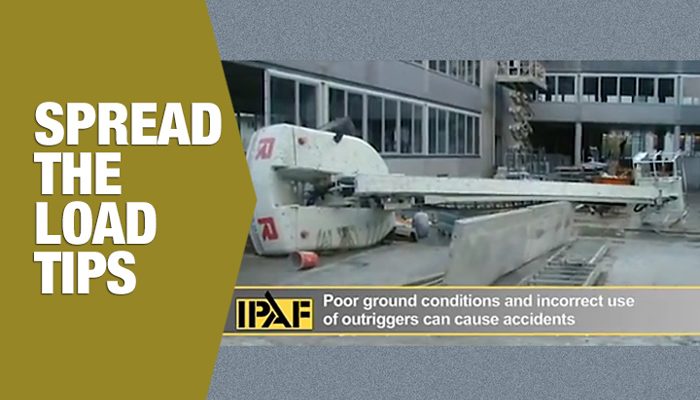
Safer MEWP use
The importance of spreader plates
The use of spreader plates with boom lifts and outriggers can save lives and minimise the risks of overturning and instability. The IPAF ‘Spread the Load!’ campaign aims to encourage the use of spreader plates with powered access platforms and prevent accidents that are caused by inadequate risk assessments of unstable ground and incorrect set up of access equipment.
Why use spreader plates?
Spreader plates reduce the heavy loads and pressure at the point of contact between a boom lift or stabilizer leg and the ground, by spreading the load through a wider area.
When they are not used, the pressure can cause problems, even on seemingly stable ground surfaces, including instability, sinking or tipping over all of which can lead to serious injury and even death.
This short four minute IPAF video demonstrates how using spreader plates reduces the risk of overturning.
A typical 18m boom can weigh more than 10 tonnes and generate a ground bearing pressure more than 14.06kg/cm. If the spreader plate is just twice the size of the outrigger foot, it can reduce the ground pressure by four times.
Risk assessments for jobs at height need to consider ground conditions and potential issues below the surface such as services. However, it can be hard to tell how solid the ground is as conditions can change with the weather and can vary even on the same site.
Choosing the right spreader plates
Selecting the right size and type of spreader plate for specific locations and access equipment is important. Spreader plates should be big enough, stiff enough and strong enough to cope with the pressure and weight demands.
The following points should be considered before the job starts:
• Identify poor ground conditions, assess the load bearing pressure of the ground and calculate the correct size of spreader for the situation
• Plate size should reduce load-bearing pressure and provide a stable footing and not sink into the ground when in use
• They should be stiff enough to create high pressure points and not sink or distort
• Plates should be strong enough to bear the load without breaking
• The plates can be made from timber, aluminium or various plastics and resins.
• Varied ground and weather conditions mean even jobs on the same site may need different plates.
Summary
In most conditions, MEWPs are very safe and stable. However, instability and overturning may result from inadequate ground assessment, poor selection of spreader plates, or incorrect positioning of outriggers. Choosing the right spreader plates can significantly reduce the risk of accidents.